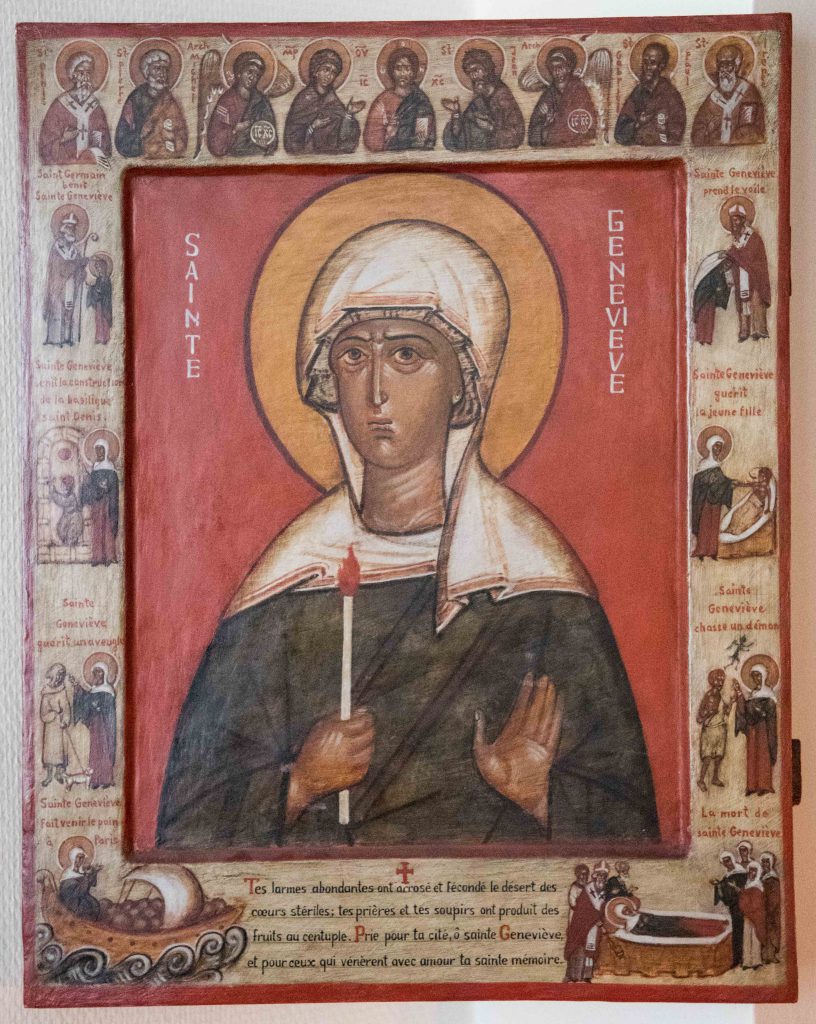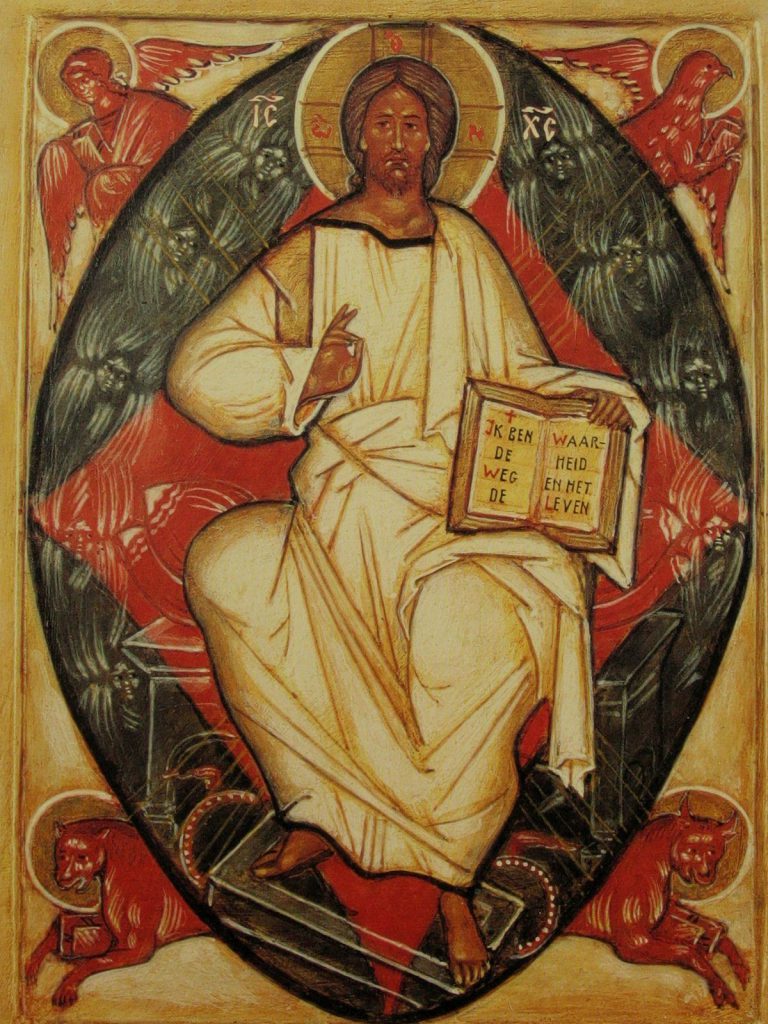Leonid Alexandrovich Ouspensky (1902-1987) is regarded as the authority in iconographic circles; sometimes even referred to as ‘the father of contemporary iconography’. The path that led to this honor has everything to do with the myriad of experiences in his personal life and the quest he undertook in discovering the fundamental value of ‘the icon’ for him.
Initially, Ouspensky certainly did not seem destined to embark on the path of iconography. In his youth, as major changes were taking place in Russia, he became involved in the radical Bolshevik movement in Zadonsk, where he was a student. As a committed atheist, Ouspensky, together with a group of young people from the surrounding villages, even went so far as to throw out icons from people’s homes.
Together with his friends, he sought to join the Red Army but was refused because of his age, he was 15 years old. A year later, in 1918, he was able to enlist. While serving, Ouspensky contracted typhus and luckily recovered, narrowly escaping certain death. Back in the army his division was ambushed and fortune again intervened as he was one of 12 survivors in his battalion: in that year, 1920, 8,000 men lost their lives. Ouspensky was taken captive and sentenced to death by a military court and immediately placed in front of firing squad, a judgment that was revoked at the last minute.
He was then transferred to the White Army where he was forced to perform the lowliest tasks before he escaped and fled to Bulgaria in 1926. There he worked in a coal mine until French recruiters enlisted him to work in a French foundry. Severely burned when he accidentally stepped into molten metal, Ouspensky was hospitalized and faced a long recovery.
While in Paris, he made contact with Tatiana Lvovna Soukhotine-Tolstoi, under whose initiative an art academy was opened in 1929. He enrolled and supported his studies working in a bicycle factory. At the Academy he met his first wife, as well as George Ivanovich Krug, the later monk and great iconographer, Grégoire Krug. While the marriage was short lived, his relationship with Grégoire Krug was lifelong and of great significance to him. It was during this time that Ouspensky painted his first icon and then destroyed it immediately, recognizing that he had done something which was ‘improper’. Gradually he began to grow in faith and moved closer to the Orthodox Church, giving himself over to painting icons.
In Paris, Grégoire Krug brought him into contact with the Brotherhood of Saint Photius, an association of émigré Orthodox theologians, including Vladimir Lossky and the Kovalevsky brothers. The Brotherhood played an important role in the Orthodox community of Paris and also in the frequent ecumenical contacts with prominent Catholic theologians who undertook an important voyage of discovery during the post-war period. They explored the teachings of the church elders and undertook an intense study of Orthodoxy.
After a period of hiding to avoid forced labor in Germany, Ouspensky met his second wife, Lydia. To protect herself as well as him, again Ouspensky went underground. It was in this period that he began to devote himself more and more to discovering the icon. In 1948, he published his first brochure, in French, with the title: L’Icône, Vision du Monde Spirituel. Later, in collaboration with Vladimir Lossky, Der Sinn der Ikonen, Graf, 1952, was published both in German and English under the title, The Meaning of Icons. This was the first book available to Western readers which introduced the fundamental spiritual and theological understanding of icons.
First within the framework of the Brotherhood of Saint Photius and then in the buildings of the Moscow Patriarchate in Paris, Ouspensky presented theological courses on iconography.
Students from all over the world followed his courses. This coursework formed the basis for the monumental work that appeared in French in 1980; La Théologie de l’Icône dans l’ Église Orthodoxe.
But in addition to this important theological and spiritual work, Ouspensky put his theories into practice. Together with Grégoire Krug, he decorated L’Église des Trois Saints Hiérarques in rue Pétel, Paris. Among many different images, Ouspensky painted scenes of the feast days of the saints as well as icons of the church’s patron saints, the three Hierarchs.
He also painted the iconostasis of his parish church in rue Saint Victor; l’Église Notre-Dame-Joie-des-Affligés et Sainte Geneviève.

Kerk van Notre-Dame joie-des-affligés et Sainte Geneviève, Paris
Many works by Leonid Ouspensky have been brought together in various publications:
Père Simon Doolan, La Redécouverte de l’Icône. La Vie et l’Oeuvre de Léonide Ouspensky, Paris, 2001, later translated into English under the title; Recovering the Icon, Crestwood, New York, 2008. Théologie en Couleur: Les Fresques des Fêtes en La Cathédrale des Trois Saints Hiérarques à Paris, published by the Patriarchate of Moscow, diocese of Chersonesus, Paris, 2007 and L’Iconographie de l’Eglise des Trois Saints Hiérarques, also published by the Patriarchate of Moscow, Paris, 2001. Finally, there is the beautiful catalog of the exhibition that took place in Paris from December 5, 2017 to January 14, 2018, entitled; Léonide Ouspensky, Le Mystère de l’Icône, also published by the diocese of Chersonesus of the Patriarchate of Moscow.
I met Leonid Ouspensky and his wife Lydia in 1980. Bernard Frinking, the first teacher I began working with in 1975, introduced me to the great master. It was a very special experience for me. I had brought several icons to the meeting and they were rigorously criticized. In the first instance, there were strong reactions to the fact that, as a Catholic, I attempted to create icons. This, to my feeling, was beside the point; nevertheless, I was encouraged to continue. Since this initial encounter, I found myself – work in tow – in the spartan but welcoming apartment on the rue Bréguet, and a warm relationship based on mutual respect and affection developed.
Leonid Ouspensky was a quiet man, but his few words, always to the point, carried the value of gold. His extraordinary gift was his ability to translate his evangelical message and deep faith into the majestic form, line and color of his icons. The value and truthful accuracy of the portrayal of an icon was for Ouspensky not simply what it represents nor the symbols used, but more importantly, how it is represented. According to Ouspensky, the iconographic language is a pictorial expression of the mystical life of the Church. Not a monolithic externalization, but an externalization that is at the same time faithful to the essential content and one that leaves room for the individuality of people, the times and the personality of the iconographer.

He was extremely sensitive to the faithfulness and authenticity of the iconographic image and immediately sensed when, in his words, “Church-strange” elements had crept into the painting. In this instance, he could react very sharply and angrily as if the ‘distortion’ he observed physically pained him. On the other hand, he could rejoice with equal fervor if the painting was concise and succinct.
This is not to say Ouspensky was an iconographic integrist. For him, an icon should have a balance between iconological tradition and creative freedom. One of his catchphrases was that an icon can never be a copy and a copy can never be an icon. For Ouspensky, bringing to an icon a personal dimension without betraying tradition or overstepping ‘rules’, was an important mark of authentic iconography. That said, it was clear to him that the personal aspect can never be ‘pursued’ or sought after intentionally but that, eluding even the creative hands of the iconographer, it ‘seeps’ into the icon unconsciously and unwittingly.
In Ouspensky’s personal quest, he familiarized himself with Roman art and acknowledged it as an authentic and justifiable form of ecclesiastical iconography. Despite the employment of a different ‘artistic language’ and style from Byzantine or Russian iconography, he recognized it as a valid Western interpretation of true beliefs and faith. And took it a step further by experimenting with the form in his search for, in his words, a “Western Orthodoxy”. This exploration did not go unnoticed by the Brotherhood of Photius, and indeed, a number of his works reflect this artistic style.
His mastery was expressed in the exploitation of the material and technical possibilities of tempera technology, wood carving and etching, with the purpose of serving the spiritual and liturgical essence of the Church. A profound religious understanding, a deep belief in prayer and a contemplative spirit, based on in-depth knowledge of the rich spiritual and theological traditions of the Orthodox Church and of the teachings of the Fathers of the Church, formed the basis for Ouspensky’s iconographic oeuvre. The humility and austerity of his lifestyle and the faithfulness with which he participated in the liturgical life of the Orthodox Church gave further support to his craftsmanship and ongoing quest.
Undoubtedly, the deep bond with his wife and co-worker, Lydia, was also an important factor, as they shared everything with each other. Lydia Ouspensky had survived her husband for many years and we had often visited her in the Russian retirement home of Sainte-Geneviève-des-Bois, near the cemetery where Leonid was buried. She now lies beside her husband.
It is our sincere hope that Ouspensky’s vision, experience and masterly craftsmanship in the creation of the icon will live on and continue to receive the attention it deserves. The insight and the transfer of experience and knowledge from master to student is the beginning point of good iconography.
Sources:
Père Simon Doolan, La Redécouverte de l’Icône. La Vie et l’Oeuvre de Léonide Ouspensky, Paris, 2001
Théologie en Couleur: Les Fresques des Fêtes en La Cathédrale des Trois Saints Hiérarques à Paris, Patriarchate of Moscow, Diocese of Chersonesus, Paris, 2007
L’Iconographie de l’Eglise des Trois Saints Hiérarques, also published by the Patriarchate of Moscow, Paris, 2001
Léonide Ouspensky, Le Mystère de l’Icône, Diocese of Chersonesus, Patriarchate of Moscow, Paris, 2017
Léonide Ouspensky, La Théologie de l’icône dans l’Église Orthodoxe, Paris, 1980
(Author: Joris van Ael)
Published in Eikonikon, Journal of Icons, no 140, (2018), 5-7
(Translator: Lorraine Weber)
